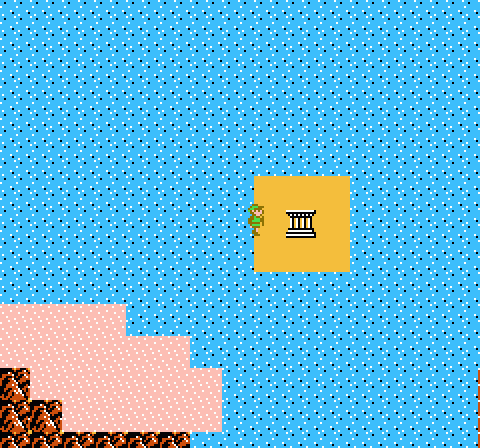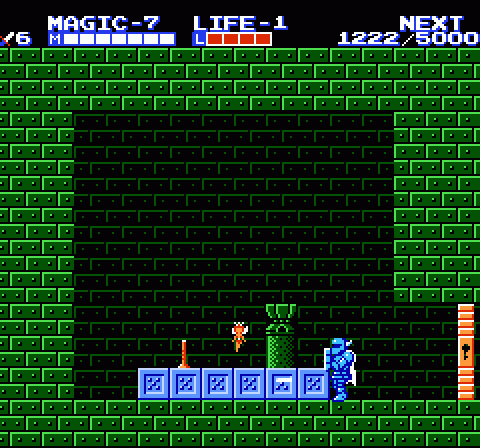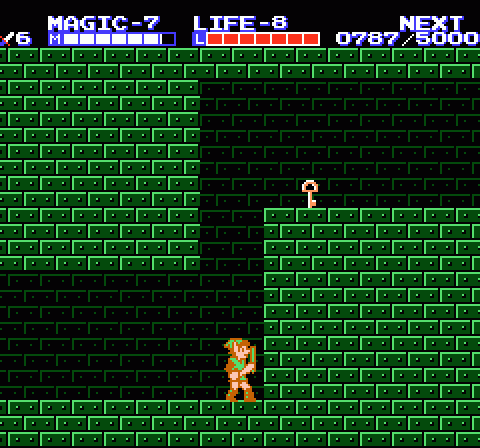After completing the Labyrinth Palace — by which I mean accomplishing its more difficult goal of acquiring the treasure inside rather than simply besting Carock — the player acquires the latest in Zelda II‘s series of funny-shaped keys. The Boots from the fourth Palace allow you to walk on water… but only a little bit of water. You can’t roam across Hyrule’s rivers and oceans with impunity simply because you’ve acquired a treasure designed for that explicit purpose. Oh, no. The only place the Boots work is in the eastern ocean to the south of the dungeon you’ve just completed.

This actually is one of Zelda II‘s more sensible design choices in guiding the player to his next goal, though. You may well chafe at the limitations imposed on the Boots; their strict range reduces them from a valuable supplement that increases the efficiency with which you putter about previously conquered grounds the way the Hammer does. Nevertheless, at this point in the game the secrets have grown increasingly abstruse, with fewer clues to your next destination appearing in towns and more potential ways and areas in which they can be hidden from your sight. By making the boots work only in the area where Link needs to find the next Palace, the designers mercifully reduce the amount of real estate you’ll end up wandering through when you inevitably find yourself stumped by another oblique puzzle.
And even then, the map designer managed to throw in a little “screw you” moment: Hidden a few spaces north of the Palace — a spot accessible only by finding an invisible single-tile path on the water — one of the final Heart Containers lurks. And, again, you can’t access the Great Palace without it. Have fun pinpointing the exact title in the vast overworld in which the one last item you need to complete the adventure has been hidden.
Invisible tile shenanigans aside, the Ocean Palace is actually the game’s most easily accessed dungeon. You can walk immediately from the Maze Palace to the Ocean Palace without stopping in a town, collecting a clue, or completing a side quest. But then, the Palace sits on a small island just off a piece of coast line that can be explored immediately once you reach the eastern continent. Most likely by this point the player will have been wondering how to get over to that island for quite some time; being able to go immediately from gathering the boots to the nearby Palace that’s been taunting you for so long feels quite satisfying.
Inside the Ocean Palace, it’s business as usual. By now the Overworld encounters should be growing less grueling as you level up Link’s skills; Fire spells cost fewer MP, enemies do less damage, and you can take down foes in fewer strikes. Nevertheless, the Palace interior is considerably less of a chore than navigating the land above.

The main objective in this Palace is the Flute, which unsurprisingly turns out to be yet another funny-shaped key that you’ll use all of twice. On the plus side, this Palace allows you to make use of one of your other funny-shaped keys, the Fairy spell, and not just for sneaking through keyholes and dodging blue Ironknuckles as above.

Granted, the mandatory Fairy spells can be a little annoying, as its magic cost is very high and you’ll want as much magic juice as possible saved up for Shield and Life, but so it goes.

At this point you’ll have seen most of the tricks present in the Ocean Palace. Like this vanishing bridge guarded by the swooping horse heads, and the fact that a bag full of EXP sits in the middle of the bridge to tempt you into doing something stupid.

Honestly, you don’t really need EXP bags in this dungeon; the new enemy type, called Mago, surrenders as much EXP per kill as you find in the bags that foes occasionally drop. Magos greatly resemble Wizzrobes; in fact, if Wizzrobes hadn’t been all over the previous dungeon, you’d be forgiven for thinking theseare Wizzrobes. Like Wizzrobes, they materialize in a random spot, cast a spell, and quickly vanish again. The main difference is that they fling fire that slowly travels forward about three spaces and lingers momentarily before flickering out as opposed to the spell beams the Wizzrobes cast. They can catch an unwary adventurer off guard and hit pretty hard, and they soak up a fair amount of damage; at full strength, Link will have to land two blows to take them down.
It’s nearly impossible to hit them straight on without being toasted by their fire, so the best technique for victory here is using the downward thrust attack. But then, that’s pretty much always true.

Case in point, the boss. Gooma barely represents a step over the “stand in one place and hammer the attack button” design of the original Zelda‘s bosses. He spends almost all of his time swinging a mace on a chain that blocks Link from hitting his vulnerable torso and inflicts considerable knockback damage. There’s no real timing possible for this fight given the fact that the boss’ attack features almost zero downtime, so the best approach is to cheese the nature of the downward thrust — while Gooma’s head is invulnerable, if you come in from above at an angle you can slide past his head and hit his torso instead.
This leaves one last Palace before the big one, though unfortunately the road beyond here ranges from “maddeningly difficult” to “soul-crushingly hard.” Not to mention enough vague goals and secrets to inspire true existential despair….